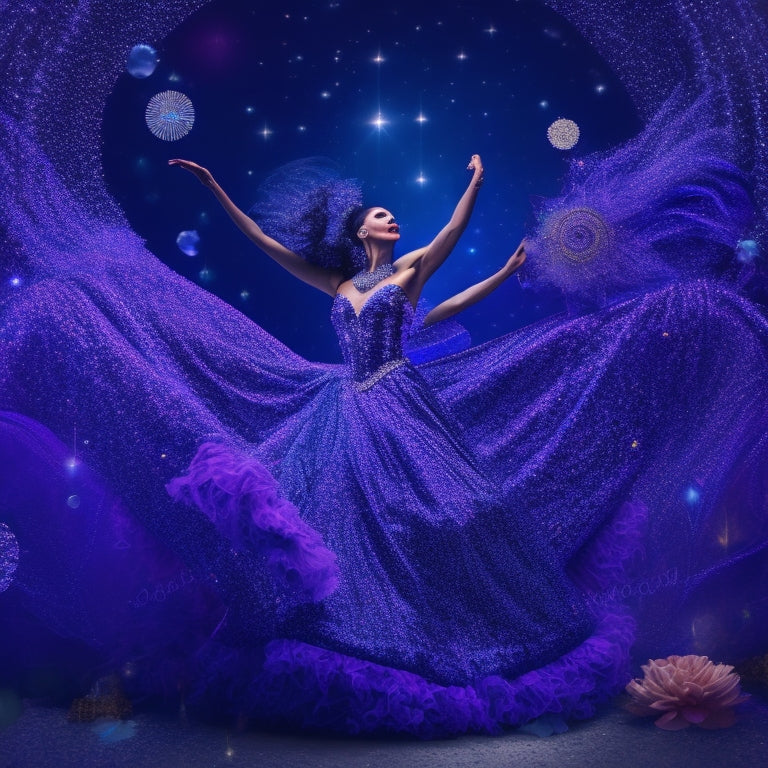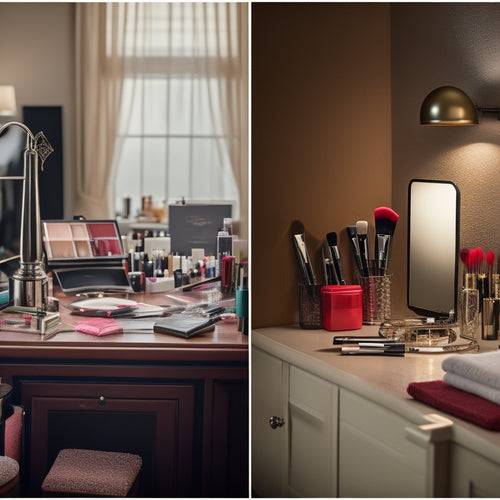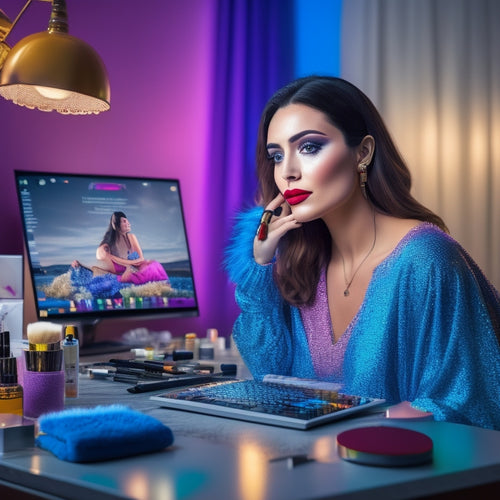
10 Digital Design Secrets for Stunning Dance Costumes
Share
You're about to reveal the secrets to crafting stunning dance costumes that dazzle and delight. Master digital makeup design essentials, like realistic skin tones and glowing complexions. Explore the secrets of color palette, from monochromatic magic to bold color blocking. Fabric texture digital magic awaits, with techniques like fabric simulation, texture mapping, and digital weave effects. Beading and sequin mastery, digital pattern making, and 3D visual effects will elevate your designs. Immerse yourself in the world of digital design and discover the limitless possibilities waiting for you.
Key Takeaways
• Master realistic high-definition skin tones to achieve a natural glow for characters and experiment with digital makeup design for flawless finishes.
• Unlock color palette secrets by creating cohesive, high-impact looks with a single hue, experimenting with shades, and incorporating gradual ombre or contrasting shades for impact.
• Utilize fabric simulation techniques to digitally weave intricate textures, experiment with fabric draping for movement, and create visual interest with virtual folding.
• Elevate costumes with intricate digital weave effects, craft futuristic fabrics with woven illusions, and control thread count and texture for hyper-realistic fabrics.
• Ignite artistic vision with lighting, texture, and color experimentation, focus on style evolution to craft immersive experiences, and consider mood and atmosphere to convey desired emotions.
Digital Makeup Design Essentials
As you delve into the world of digital makeup design, mastering the art of creating realistic, high-definition skin tones is vital to bringing your dance costume characters to life. You want your characters to radiate a natural glow, as if they're about to step onto the stage.
To achieve this, it's essential to understand the subtleties of skin tones. From porcelain doll-like complexions to sun-kissed, golden brown hues, each tone requires precision and attention to detail. With digital makeup design, you have the power to experiment and perfect your craft.
Virtual try-on features allow you to test different skin tones on your characters, ensuring a flawless, realistic finish. By honing in on the nuances of skin tones, you'll discover the key to creating characters that exude confidence and charisma.
Unlocking Color Palette Secrets
As you design your dance costume, you'll want to harness the power of color to evoke emotion and make a statement.
By mastering monochromatic magic, you can create a cohesive look that's both sophisticated and striking.
Meanwhile, bold color blocking can add a dynamic, high-energy vibe to your design, so get ready to explore the endless possibilities!
Monochromatic Magic Happens
By limiting your dance costume design to a single hue, you can create a cohesive, high-impact look that unifies your dancers and amplifies the overall visual effect. This monochromatic approach allows you to focus on subtle nuances in shade and texture, adding depth and interest to your design.
To get started, create a mood board that showcases your chosen color in various forms - fabrics, flowers, or even paint swatches. This visual representation will help you refine your color harmony and guarantee a cohesive look.
As you explore different shades of your chosen hue, consider how they'll work together to create a visually stunning effect. You might opt for a gradual ombre effect, with darker shades at the bottom of the costume and lighter shades towards the top. Alternatively, you could use contrasting shades to create a striking visual impact.
Bold Color Blocking
You'll often find that bold color blocking adds an extra layer of excitement to your dance costumes, allowing you to play with contrasting hues and cleverly crafted color combinations that pop against the stage lights. This technique is all about creating visual interest by dividing your design into sections of bold, vibrant colors. By doing so, you'll create a visually striking look that's sure to captivate your audience.
Here are some bold color blocking ideas to get you started:
| Color Combination | Inspiration |
|---|---|
| Bright Coral + Deep Navy | Summer Sunset |
| Electric Blue + Neon Green | Neon Rave |
| Hot Pink + Metallic Gold | Glamorous Disco |
To take your bold color blocking to the next level, incorporate geometric patterns and vibrant accents to add an extra layer of visual interest. Consider adding geometric shapes like triangles, chevrons, or polka dots to create a dynamic look. You can also add vibrant accents like sequins, glitter, or rhinestones to give your costume an extra touch of glamour. With bold color blocking, the possibilities are endless, and the result is always a show-stopping dance costume that's sure to dazzle the audience.
Fabric Texture Digital Magic
As you step into the world of digital fabric design, you're about to discover the secrets to creating textures that look and feel like the real thing.
By mastering fabric simulation techniques, you'll be able to mimic the intricate weave of lace, the smooth sheen of silk, or the roughness of burlap.
With texture mapping methods and digital weave effects at your fingertips, you'll be able to craft dance costumes that shimmer, shine, and sway with mesmerizing realism.
Fabric Simulation Techniques
With fabric simulation techniques, you can digitally weave intricate textures, from the subtle sheen of silk to the rustic roughness of burlap, imbuing your dance costumes with a tangible, three-dimensional quality. This digital magic allows you to experiment with various fabrics, draping, and folds, giving you unparalleled creative freedom.
Here are some exciting ways to leverage fabric simulation techniques in your design process:
-
Fabric Draping: Simulate the natural flow and drape of fabrics, creating a sense of movement and fluidity in your costumes.
-
Virtual Folding: Experiment with intricate folds and creases, adding depth and visual interest to your designs.
-
Texture Manipulation: Alter the texture, weave, and pattern of fabrics to achieve unique, one-of-a-kind looks.
- Material Blending: Combine different fabrics to create innovative, hybrid materials with distinct properties.
Texture Mapping Methods
By applying texture mapping methods, your digital dance costumes can burst with intricate patterns, from the subtle shimmer of lame to the rich embroidery of velvet, inviting viewers to step into a world of tactile wonder.
With Normal Mapping, you can add depth and dimension to your designs, creating an illusion of raised patterns and textures that seem to jump off the screen. This technique is especially effective for capturing the intricate details of fabrics like lace or brocade.
For a more dramatic effect, try Bump Mapping, which uses grayscale images to simulate the way light interacts with textures. This technique can add a sense of realism to your designs, making it seem as though the fabrics are rippling or undulating in the light.
Digital Weave Effects
You'll elevate your digital dance costumes to the next level by mastering digital weave effects, which allow you to meticulously craft the intricate interlacing of threads, the subtle sheen of silk, or the soft, downy pile of velvet, evoking a tactile response in your audience.
With digital weave effects, you can create Futuristic Fabrics that transport your audience to a world of Woven Illusions.
Here are some ways to harness the magic:
-
Micro-weave manipulation: Control the thread count, density, and texture to achieve hyper-realistic fabrics.
-
Fabric fusion: Combine contrasting textures and materials to create truly unique, eye-catching effects.
-
Optical illusions: Use digital weave effects to create the illusion of movement, depth, or even 3D patterns on your costumes.
- Illuminated fabrics: Infuse your digital fabrics with luminescent properties, adding an extra layer of drama to your designs.
Beading and Sequin Mastery
Every intricate dance costume features a mesmerizing array of beads and sequins that shimmer and shine under the stage lights, drawing the audience's gaze to the dancer's movements. As a digital designer, you're about to reveal the secrets of beading and sequin mastery to elevate your designs to the next level.
Delve into the fascinating world of sequin history, where you'll discover how these tiny discs have been used to adorn royal attire and theatrical costumes for centuries. From the opulent Versailles to the vibrant streets of Rio, sequins have been a staple of extravagant fashion.
Today, beading trends are all about mixing and matching different shapes, sizes, and materials to create show-stopping designs. You'll learn how to balance bold statements with subtle accents, crafting a visual narrative that tells a story on stage.
With beading and sequin mastery, you'll be able to transform your digital designs into dazzling, attention-grabbing costumes that bring the house down.
Digital Pattern Making Pro
As you master the art of beading and sequin design, your next challenge is to bring those intricate patterns to life on the dancer's body, and that's where your skills as a Digital Pattern Making Pro come into play. You're no longer limited by traditional methods; instead, you can create complex patterns and shapes with ease, using digital tools to automate and streamline your design process.
Here are 4 ways to take your digital pattern making skills to the next level:
-
Embrace pattern evolution: Use software to create iterative designs, experimenting with different shapes and styles until you land on the perfect look.
-
Leverage design automation: Let algorithms handle repetitive tasks, freeing you up to focus on the creative aspects of your design.
-
Experiment with 3D visualization: See your designs come to life in stunning 3D, allowing you to make adjustments and tweaks with precision and accuracy.
- Collaborate with others in real-time: Share your designs with colleagues and clients, getting instant feedback and making changes on the fly.
Costume Rendering Techniques
With digital pattern making mastered, it's time to bring your designs to life with photorealistic costume renderings that transport clients and dancers into the world of your imagination. You're now ready to ignite your artistic vision, experimenting with lighting, texture, and color to evoke emotions and tell a story.
As you immerse yourself in costume rendering techniques, remember that style evolution is key. You're not just creating a costume, you're crafting an experience. Think about the mood and atmosphere you want to convey. Do you want to evoke the grandeur of a bygone era or the sleekness of modernity? The possibilities are endless, and it's up to you to bring your vision to life.
With every brush stroke, every adjustment to lighting and texture, you're one step closer to realizing your artistic vision. You're not limited by the constraints of physical materials or traditional techniques. The digital world offers you the freedom to experiment, to push boundaries, and to create something truly breathtaking.
Creating 3D Visual Effects
You step into the world of 3D visual effects, where the boundaries of reality blur and the impossible becomes possible, allowing you to conjure mesmerizing illusions that transport your audience to new dimensions.
As a digital designer, you have the power to create breathtaking dance costumes that defy gravity, shimmer with iridescent colors, or glow with an ethereal light. The possibilities are endless, and the tools at your disposal are more powerful than ever.
Here are 4 ways to take your 3D visual effects to the next level:
-
Experiment with Realistic Lighting: Create dramatic, high-contrast lighting scenarios that make your costumes pop with depth and dimension.
-
Dive into Virtual Reality: Transport your audience into immersive, 360-degree environments that surround them with your stunning costume designs.
-
Push the Boundaries of Physics: Use 3D simulations to create impossible, gravity-defying movements and interactions that leave your audience in awe.
- Unleash Your Creativity with Dynamic Simulations: Bring your costumes to life with dynamic simulations that respond to music, movement, and environment.
With these techniques, you'll be able to craft 3D visual effects that mesmerize and inspire, elevating your dance costumes to new heights of creativity and wonder.
Lighting and Shading Secrets
Vibrant hues and subtle nuances of light bring your digital dance costumes to life, and mastering the art of lighting and shading is essential to creating an unforgettable visual experience.
You can elevate your designs by experimenting with different lighting setups, from dramatic spotlights to soft, ethereal glows. Ambient Occlusion (AO) adds depth and dimension to your costumes, simulating the way light interacts with fabrics and textures. By incorporating AO, you can create intricate folds, creases, and folds that seem to leap off the screen.
To add an extra layer of realism, try incorporating Volumetric Lighting into your design. This technique simulates the way light behaves in 3D space, creating an immersive atmosphere that draws the viewer in. By balancing light and shadow, you can create a sense of drama and tension, drawing attention to specific design elements or highlighting the dancer's movements.
With these lighting and shading secrets, you'll be able to craft digital dance costumes that shimmer, shine, and mesmerize – transporting your audience to a world of creative freedom.
Digital Fabric Manipulation
Fabric simulation software allows you to digitally drape, pleat, and gather fabrics, enabling you to craft intricate, realistic textures that flow and move in harmony with the dancer's body. You can experiment with different fabrics, weights, and textures, creating a digital fabric library that's all your own. This freedom to explore and express yourself is unparalleled in traditional costume design.
Here are just a few ways you can ignite your creativity with digital fabric manipulation:
-
Fabric draping: Create intricate folds and drapes that flow like a dancer's movement.
-
Virtual embroidery: Add intricate patterns and designs that shimmer and shine under the stage lights.
-
Texture manipulation: Add subtle texture and depth to your fabrics, giving them a life-like quality.
- Realistic movement: Simulate the way fabrics move and flow with the dancer's body, creating a truly immersive experience.
With digital fabric manipulation, the possibilities are endless. You're no longer limited by the constraints of traditional fabric or sewing techniques. You're free to push the boundaries of creativity and bring your most daring designs to life.
Bringing Designs to Life
As you bring your designs to life, you're not just creating costumes - you're crafting an immersive experience.
You'll weave together visual storytelling elements, carefully balancing color, texture, and pattern to evoke emotions and convey the dancer's narrative.
Visual Storytelling Elements
When you incorporate visual storytelling elements into your dance costume designs, you're not just creating a look, you're crafting an entire narrative that unfolds across the dancer's body. This is where the magic happens, and your design comes alive. By integrating visual storytelling elements, you're giving the audience a deeper understanding of the performance, and inviting them to be a part of the story.
Here are some key visual storytelling elements to ponder:
-
Mood Boards: A visual representation of your design concept, showcasing colors, textures, and inspirations.
-
Storyboarding: A sequence of sketches or images that illustrate the dancer's movements and interactions with the costume.
-
Character Development: Reflect on the dancer's personality, backstory, and motivations to inform your design decisions.
- Symbolism and Metaphor: Infuse symbols, patterns, or motifs that hold meaning and add depth to the narrative.
Digital Fabric Rendering
With digital fabric rendering, you can unlock your design concepts from the world of imagination to tangible, breathtaking reality, where intricate textures, luminous colors, and flowing silhouettes come alive on the dancer's body.
This powerful tool allows you to visualize and refine your designs with uncanny accuracy, ensuring that your creative vision is executed flawlessly. By harnessing the power of Fabric Physics, you can simulate the behavior of fabrics in a virtual environment, predicting how they'll drape, fold, and respond to movement.
This means you can experiment with different textures, weights, and weaves, and see how they interact with the dancer's body in real-time. Virtual Drape technology takes this a step further, enabling you to create stunning, photorealistic renderings that showcase your design in exquisite detail.
With digital fabric rendering, the possibilities are endless, and the freedom to explore and express yourself is unparalleled. So unlock your creativity, and bring your most daring designs to life!
Frequently Asked Questions
Can I Use Digital Design for Costumes in Other Performing Arts?
You can evoke Theater Magic in Opera Fusion by applying digital design to costumes, blending innovative textures, vibrant hues, and futuristic patterns, freeing you to express bold, avant-garde statements on stage.
How Do I Protect My Digital Designs From Being Stolen or Copied?
To safeguard your digital masterpieces, you'll want to employ clever watermarking strategies and robust encryption methods, ensuring your creations remain yours alone, freely expressing your artistic vision without the fear of theft or duplication.
Are Digital Design Skills Transferable to Other Creative Industries?
As you expand your creative horizons, you'll find your digital design skills are highly transferable to other industries, from visual merchandising to architecture. Develop a strong digital portfolio showcasing your versatility, and industry applications will emerge, revealing new avenues for artistic freedom.
Can I Use Digital Design to Create Costumes for Film and TV Productions?
Did you know 80% of Oscar winners in costume design utilized digital tools? You can bring film and TV characters to life by leveraging digital design to guarantee Production Realities meet Costume Accuracy, enabling creative freedom for your designs.
Do I Need to Know How to Sew to Be a Digital Costume Designer?
You don't need to know how to sew to be a digital costume designer, as software proficiency and design fundamentals are key; your creative vision can thrive without sewing skills, giving you the freedom to focus on visual storytelling.
Related Posts
-

3 Pro Tips to Overcome Makeup Task Procrastination
You're stuck in a never-ending cycle of makeup task procrastination, feeling overwhelmed by the complexity of the tas...
-

5 Best Free YouTube Dance Makeup Tutorials
You're ready to elevate your dance performances with stunning makeup looks, and we're here to help! Our top 5 free Yo...
-

Festive Reindeer Cross Stitch Pattern Delights Crafters
This festive reindeer cross stitch pattern, featuring Dancer, one of Santa's beloved reindeer, is a delightful treat ...


